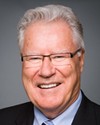Thank you.
Mr. Chair, members of the committee, my name is Patrick Borbey, and I am President of the Canadian Northern Economic Development Agency, or CanNor. Joining me today is CanNor's Chief Financial Officer, Yves Robineau.
I am pleased to be here today to discuss CanNor's main estimates and supplementary estimates (A). I appreciate the opportunity to provide the committee with a short overview of the agency's work and priorities.
The Prime Minister created CanNor in August 2009, and we are approaching the five-year mark in our mandate to foster a diversified, sustainable and dynamic economy across Canada's three northern territories.
I will divide my remarks into three broad themes, Mr. Chairman: the impact of our programs and services in the north; the work of the northern projects management office; and our efforts to build a strong, skilled, and diversified workforce.
Mr. Chair, this year CanNor will deliver about $40 million in contribution programs and services to foster economic development in the north. Since 2009, CanNor has invested over $185 million in 910 projects. Many of these projects are funded through CanNor's two key contribution programs: first, the strategic investments in northern economic development, or SINED, program; and, second, the new northern aboriginal economic opportunities program, or NAEOP.
Supplementary estimates (A) provide $40 million over two years to renew SINED as a program to promote economic diversification and to strengthen the driver sectors of the northern economy. As examples of past SINED initiatives, I would cite the $16 million that we've invested since 2009 to obtain geoscience data in the three territories. This encourages exploration and helps foster further private sector investments in the tremendous natural resource potential of Canada's north. Last month, some $350,000 of SINED money helped the City of Iqaluit build a micro auto gasification system as an innovative solution to waste management that also addresses the challenges northerners face in finding affordable energy.
In the Northwest Territories, earlier this month, Minister Aglukkaq announced an investment of $600,000 to help Denendeh Investments Incorporated undertake multiple planning activities related to opportunities in the mining, energy and transportation sectors. That initiative will help increase ownership and benefits for aboriginal companies and communities in the territory.
In the Yukon, we supported the Adäka Cultural Festival, which not only brings tourism revenues to Whitehorse but also increases awareness and demand for Yukon first nations' arts, crafts and cultural experiences.
Indeed, many investments CanNor has made in small business in the north are linked to the tourism industry in the territories.
In Nunavut, we have helped build the fishing industry, which currently employs 300 seasonal fisherpersons and was estimated to be worth approximately $79 million in 2012-2013. We helped sponsor the territory's fisheries strategy. We have funded studies to explore the turbot fishery in the Arctic Ocean and a training simulator to help Inuit prepare for a career in the fishing sector, and helped Nunavut-based companies purchase fishing vessels.
To better align with the federal framework for aboriginal economic development, CanNor has streamlined and harmonized its aboriginal economic development programming under a northern aboriginal economic opportunities program. This was launched on April 1, 2014. NAEOP is opportunities-driven, focused on results, and geared towards maximizing economic opportunities for aboriginal communities and businesses.
Over the years, CanNor's support to aboriginal economic development can point to many successes, including supporting communities to negotiate impact benefit agreements with resource development companies, helping start and grow aboriginal small businesses, and developing community capacity so that northerners can participate in and benefit from economic activity in the region.
These investments may be modest relative to the budgets of some of the major resource initiatives currently under development, but they have an important impact on the economy of the north. Of the northern and aboriginal individual or community-owned businesses supported by the agency's aboriginal economic development programs, 88% were still in operation after their third year.
Mr. Chairman, resource development is a key driver for broader economic development in Canada's north. At this time there are 33 major projects in the north that are either in or preparing to enter into the regulatory process. These projects represent more than $26.9 billion in capital investment and more than 11,600 jobs, should the projects go forward.
CanNor is unique among regional development agencies in that our mandate includes the northern projects management office, or NPMO. NPMO plays a key role in working with both industry and communities to advance responsible resource development in the three territories. The NPMO shepherds resource projects through the regulatory process in a way that anticipates and addresses challenges. It coordinates all federal regulators to ensure the timeliness, transparency, and predictability of regulatory efforts, while overseeing the crown's aboriginal consultation requirements.
While we are helping major resource project proponents through the regulatory process, we also bring them together with communities to help build local capacity and readiness to take advantage of this economic activity. Through our community readiness initiative, CanNor promotes the full involvement of aboriginal people in resource development projects taking place near their communities. We also seek ways in which local people can contribute their skills and training to resource projects. For the companies and the communities, this is a win-win situation.
Mr. Chairman, the third theme I would like to touch on briefly today involves the agency's efforts to build a strong, skilled, and representative workforce in the north, which is a key factor in ensuring strong and sustainable economic development throughout the north.
In 2012 we launched the northern adult basic education program, a five-year program to give northerners access to training that will position them to participate in the labour market as the economy grows. This program is delivered through the territorial colleges, and in its first year of operation offered more than 60 programs to more than 800 adult learners.
We are also investing in a number of training projects. I have mentioned training in Nunavut for people who wish to enter the fisheries industry. We are also investing $5.6 million over four years to help establish a centre for northern innovation in mining in Yukon to deliver the education and training required for skilled local jobs in the mining and exploration sector.
Another project, the Inuit learning and development pilot project, is a joint project between the federal government, the Government of Nunavut, and Nunavut Tunngavik Incorporated. This pilot project involves four, four-month, paid work assignments in different public service positions for up to 16 participants. It also includes a suite of culturally adapted training modules and one-on-one mentorship. It's already showing signs of success as a means to increase the number of Inuit working in the public sector in Nunavut. It is initiatives like this that will help the agency create a more representative skilled workforce over the long term.
Mr. Chair, I have only touched on a few examples of how CanNor helps foster a strong, diverse and sustainable economy across the three territories. Our programs and services help create jobs, prosperity and long-term growth in the north. We are a key player in the government's commitment to providing a foundation for a prosperous economic future for those who live, work and support their families in the north.
I would be pleased to answer the committee's questions.
Thank you very much.






